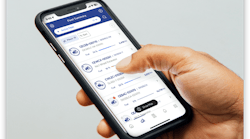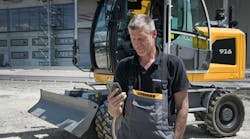Declan McGrath was a surveyor by background, but he eventually found himself responsible for machine control for his company’s fleet. In a 10-year period, he’s gone from little knowledge of machine-control systems to responding to thousands of support calls about machine control.
His very first experience with machine control, or “machine guidance,” as he often calls it, was in 2004, on a single machine: a Caterpillar D6R dozer with a Trimble SiteVision system.
Save Labor, Costs and Competitiveness
Much like telematics, machine control can look complicated to the unitiated; this is especially true in an application such as concrete curb work. The benefits, however, can outweigh appearances.
“It is not the Herculean effort that some people think it is to make the switch from using stakes and string to a stringless machine-control system,” says Stephen Bullock, VP of Sales & Marketing for Power Curbers. “For a small curb contractor, it is going to require having someone on staff who is comfortable with 3D and 3D modeling; that’s the warning going in.”
Bullock says it’s all about labor and cost savings.
“Once they’re through the learning curve, there is a huge labor-saving potential in not having to set stringline any longer,” he says. “It’s becoming increasingly difficult to find labor that is willing to drive pins in the ground.”
A second factor is that more jobs are being 3D modeled and there are no traditional grade stakes involved. There’s an added cost for the project developer or owner to have to bring a surveyor out.
“It’s adding cost to the developer to have a survey crew to come out and set the stakes just for the curb guy,” Bullock says. “Pretty soon the contractor without stringless controls is going to be at a big disadvantage and is going to be forced to charge more per linear foot when that surveying is figured in.”
And charging more for jobs may make that contractor less competitive. Does Bullock see a day when no owner/developer is willing to hire a survey crew?
“I see that as very realistic on larger jobs. There will always be small commercial parking lots that will not be 3D modeled, but on larger jobs that’s absolutely the direction it’s going,” he says.
Today, 60 key pieces in the company’s fleet of 230 earthmovers are equipped with machine control, and McGrath is firmly entrenched as the company expert, and operating under his third different title.
McGrath, who works for the Daracon Group in Newcastle, Australia, a family-owned civil contracting company with 800 employees, told session attendees at the most recent Trimble Dimensions event in Las Vegas how to make a similar journey.
Machine-control benefits such as increased fleet reliability, improved utilization, improved accuracy, and greater ROI don’t come automatically.
Taking ownership
“You have to take ownership of machine control,” McGrath says. “A person taking ownership will take responsibility for the successes and failures of their machine control-equipped fleet. They’ll also actively monitor and improve the machine-control systems in order to maximize benefit—and they won’t be over-reliant on their machine-control dealer.”
According to McGrath, part of how you take ownership is accepting that your success using machine control is ultimately your responsibility—not the manufacturer’s.
“The manufacturer provides you with tools and advice, but they are not part of your business,” he says. “Accepting this attitude means working for productivity gains, not simply waiting for them.”
To take ownership, McGrath recommends designating a dedicated machine-control expert. “This person will be critical to the success of all subsequent advice,” McGrath says.
There are a number of skills and aptitudes the candidate should possess, including basic machine-fitting knowledge, the ability to use hand tools, high computer literacy, auto-electrical skills and knowledge, surveying, and high-level problem-solving skills.
And, as in McGrath’s experience, know that most training on machine control will be “on the job” training.
Necessary tools
Here are the tools and equipment a machine-control expert requires: a basic 120-piece automotive tool kit; a butane-powered soldering iron; tape measure; smart level and measure-up tool; a thread-tap set; and a laptop, programming cables and software.
Beyond a well-stocked toolbox, the machine-control expert for the company should also have the following on hand:
- Common cables (receiver, tilt-bucket, sensor)
- Common sensors (AS400, AS450)
- Common bolts and fasteners
- Fuses
- Deutsch plugs
- RAM hardware and ratchet clamps
As far as purchasing, McGrath says the company expert should seek out plug-and-play technology.
“Purchasing and installing everything yourself except cab kits creates flexibility in your fleet,” McGrath says. “And control boxes and receivers are to be purchased when constant demand is identified.”
He adds that a small amount of equipment can be rented when demand fluctuates.
Also, hardware standardization becomes necessary when hardware is being moved across the fleet, and it’s necessary to have common firmware, common option codes, and common mounting options.
“Standardization also applies to models and data; consider building models to FL, not subgrade, use a color convention for linework, and use a naming convention for models,” McGrath says.
He also advises fleets—and this should be music to the ears of equipment managers—to take an asset management view of machine-control equipment.
“Considering the monetary value of the assets, a well-maintained register of all machine-control assets is required,” he says. “Internal clients should be charged daily rental to assist with achieving good utilization.”
McGrath says another benefit will be increased operator confidence through machine-control system training, communication (include diagrams to help with understanding, McGrath says), regular accuracy checks, and regular calibration.
“A more confident operator works efficiently and accurately, and is more apt to make use of all system features,” he says.
“Successful use of machine control involves more than purchasing some machine-control systems and sitting back to enjoy the benefits,” McGrath says. “After the tools have been provided by your distributor, the potential for achieving massive gains in productivity lands with you.”
Measuring ROI
Along with measuring productivity, the machine-control expert will have to know how to calculate ROI. How fast will the technology pay for itself? To start, it’s important to know what to measure, according to Owen Noll, controller, Trimble Heavy Civil Construction & Mining. “For what to count, there are three categories: investments, expenses and returns,” Noll says. “It’s important to establish a complete list.”
Investments include the obvious, such as equipment, software, set-up costs and installation, but also less obvious items like training (fees and time) and upgrades.
On the expense side, make sure to consider subscriptions, support and warranties, 3D modeling, equipment-management tracking, system operation, data processing and reporting, and any financing expenses.
Contrast the investments and expenses versus the following returns:
- Materials, fuel, stakes
- Time (operators, machine wear, staff)
- Rework avoidance
- Bonuses/penalties
- Reduced hiring, financial and insurance expenses.
It also helps to make real-world comparisons when thinking about the equation. “If you find your investment is $4,000 per month, another way to look at it would be to ask ‘What would it take to justify that money?’” Noll says. “It could be 40 hours of any machine time, 1,400 gallons of fuel, 25 to 50 percent of a person, 15 hours in traffic, or one surveyor visit.”





